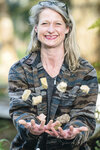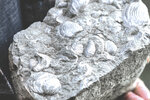

“What’s the beach offering today?” Shannon Fenton asked herself.
A recent storm had churned the water in Case Inlet. It was high tide and overcast on a late March morning, and Joemma Beach was littered with a fresh stock of quartz and jasper. Both types of stone are pretty easy to find on Key Peninsula beaches — if you have the eye for it.
“Come here at 4 p.m., and the tide is low, and the sun is shining, and this beach would be glowing,” said Fenton, a self-proclaimed “rockhound.”
Rockhounds are rock collectors and gem enthusiasts — some consider themselves amateur geologists. It’s a hobby that’s increased significantly across the state since the pandemic and, according to Fenton, it’s probably one of the easiest to get into.
Her advice for newbies is simple: “Start by picking up rocks that are pretty. Then start focusing on the ones you really like.” For Fenton, that’s picture jasper, but finding blue agates is her new obsession.
“Looking for a specific stone is like an Easter egg hunt,” she said. “Then when you find it, it’s like Christmas.”
Fenton’s affinity for the hobby has a more somber origin. She got into it as a way to cope with the death of her 19-year-old son in 2013.
“If I stayed home to grieve, I would’ve surely sunk to the bottom pits of depression,” she said. “I walk out into nature and can ‘ugly bawl’ my heart out. Nature isn’t offended by your tears. It offers sunshine for warmth and peace, wind as a hug and a push-forward, and rain to wash away your tears. Then nature shows you her beauty.”
In Fenton’s eyes, that beauty is in the form of crystals, jasper, opals and agates. She started a therapeutic rock garden, creating designs from the rocks she brings back to her Lakebay home. Each rock gathered serves as both a memorial and reminder to work at making peace with the death of her son, and seven years later the death of her 27-year-old nephew.
Occasionally during her excursions, Fenton finds rocks on local beaches she knows aren’t from around the area. She said she always wondered where these rocks came from.
That’s the work of 67-year-old Lakebay resident and 40-plus year rockhound, John Hubbard. Hubbard, a member of the Kitsap Mineral and Gem Society, has so many rocks in his collection that he spreads them on the beaches as a way to generate interest from potential new hounds. Recently retired from a career in retail sales, Hubbard is an “agate guy” who leads field trips for members of the society. He said he enjoys going on adventures to search for the stone and no matter how many he has, it’s still exciting.
“You hunt, you dig, and when you find one, you just found buried treasure no one has ever seen before,” he said.
Hubbard also regularly donates buckets of agates and petrified wood to Wild Earth, a Key Peninsula rock and gift shop near SR 302 and 118th Avenue NW, to give out free to kids. At a time when a lot of small businesses were going to an online model, owners Dave and Jenny Weber decided to open the brick-and-mortar shop in November 2021 to develop a better connection with the people in the community. Jenny is a longtime rockhound, spending summers as a kid collecting agates and sapphires in Montana, while Dave came in with limited knowledge about the rock and gem world.
“I’m not afraid to admit I glean a lot of information from our customers,” Dave said. “Part of the fun is being able to learn while meeting new people who obviously have a passion for this.”
Though Wild Earth features items like jewelry, paintings, greeting cards, bath products and books from local and Washington artists, they purposely don’t feature rocks customers can find around the KP. They encourage people to go find those stones on their own.
Social media trends spurred on by TikTok have driven up the popularity of certain rocks and minerals to a point where it’s tough for Wild Earth to keep them in stock.
“We had this stone called elite shungite sitting in a closet for over a year, and no one asked about it,” Dave said. “Then all of the sudden five people wanted all of it.” Same goes for flower agate, moldavite and hematite.
Another rockhound taking advantage of social media is recent Herron Island transplant Kasey Lane Brooks. The lapidary artist and silversmith moved to the area from Steamboat Springs, Colorado, last summer and immediately began creating jewelry using the rocks she foraged on the beaches around the island. She uses Facebook and Instagram to drive followers to her Etsy site where she sells her handmade jewelry.
Brooks has such a following that 70% of her business is based on custom orders. Like Fenton, the former radio and TV host turned to rock hounding for therapeutic reasons. Her husband passed away 10 years ago from a form of lymphoma. “I learned the more time I spent in nature, the less anxiety I felt,” she said. “When I’m looking for stones, I have no time to worry. (Rockhounding) has been an actual live saver.”
All agree rock hounding is an affordable hobby for families to get into together. Hubbard said you can get a rock hammer and a few buckets for less than $35. “If you’re a casual rockhound those tools can last you a lifetime,” he said. He also suggested starting out with a six-pound rock tumbler to polish the stones.
Most hounds keep their search sites a secret, but Fenton said part of the adventure is finding a place on your own. There are YouTube channels and websites like Mindat.org, the Washington Mineral Council and the Washington State Department of Natural Resources, which show where digging and taking rocks is allowed.
“It’s the thrill of the hunt. Every time I go out I find at least one thing I think is cool; sometimes it’s a bucketful,” Fenton said.
UNDERWRITTEN BY THE FUND FOR NONPROFIT NEWS (NEWSMATCH) AT THE MIAMI FOUNDATION, THE ANGEL GUILD, ADVERTISERS, DONORS AND PEOPLE WHO SUPPORT INDEPENDENT, NONPROFIT LOCAL NEWS